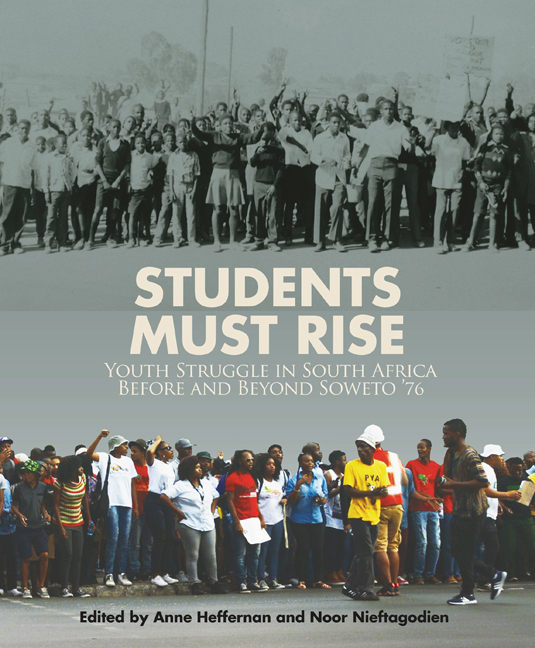Book contents
- Frontmatter
- Acknowledgements
- Contents
- Timeline
- Map Of South Africa
- Glossary
- Abbreviations
- Introduction: narratives of the student struggle
- Chapter 1 A brief history of the African Students’ Association
- Chapter 2 Youth and student culture: Riding resistance and imagining the future
- Chapter 3 The role of religion and theology in the organisation of student activists
- Chapter 4 Student organisation in Lehurutshe and the impact of Onkgopotse Abram Tiro
- Chapter 5 The University of the North: A regional and national centre of activism
- Chapter 6 Action and fire in Soweto, June 1976
- Chapter 7 What they shot in Alex
- Chapter 8 SASO and Black Consciousness, and the shift to congress politics
- Chapter 9 Youth politics and rural rebellion in Zebediela and other parts of the “homeland” of Lebowa, 1976–1977
- Chapter 10 My Journey, our journey: Activism at Ongoye University
- Chapter 11 ‘Let's begin to participate fully now in politics’: Student politics, Mhluzi township, 1970s
- Chapter 12 ‘They would remind you of 1960’: The emergence of radical student politics in the Vaal Triangle, 1972–1985
- Chapter 13 The ends of boycott
- Chapter 14 Fighting for ‘our little freedoms’: The evolution of student and youth politics in Phomolong township, Free State
- Chapter 15 ‘Every generation has its struggle’: A brief history of Equal Education, 2008–15
- Chapter 16 Contemporary student politics in South Africa: The rise of the black-led student movements of #RhodesMustFall and #FeesMustFall in 2015
- Selected Bibliography
Chapter 2 - Youth and student culture: Riding resistance and imagining the future
Published online by Cambridge University Press: 21 April 2018
- Frontmatter
- Acknowledgements
- Contents
- Timeline
- Map Of South Africa
- Glossary
- Abbreviations
- Introduction: narratives of the student struggle
- Chapter 1 A brief history of the African Students’ Association
- Chapter 2 Youth and student culture: Riding resistance and imagining the future
- Chapter 3 The role of religion and theology in the organisation of student activists
- Chapter 4 Student organisation in Lehurutshe and the impact of Onkgopotse Abram Tiro
- Chapter 5 The University of the North: A regional and national centre of activism
- Chapter 6 Action and fire in Soweto, June 1976
- Chapter 7 What they shot in Alex
- Chapter 8 SASO and Black Consciousness, and the shift to congress politics
- Chapter 9 Youth politics and rural rebellion in Zebediela and other parts of the “homeland” of Lebowa, 1976–1977
- Chapter 10 My Journey, our journey: Activism at Ongoye University
- Chapter 11 ‘Let's begin to participate fully now in politics’: Student politics, Mhluzi township, 1970s
- Chapter 12 ‘They would remind you of 1960’: The emergence of radical student politics in the Vaal Triangle, 1972–1985
- Chapter 13 The ends of boycott
- Chapter 14 Fighting for ‘our little freedoms’: The evolution of student and youth politics in Phomolong township, Free State
- Chapter 15 ‘Every generation has its struggle’: A brief history of Equal Education, 2008–15
- Chapter 16 Contemporary student politics in South Africa: The rise of the black-led student movements of #RhodesMustFall and #FeesMustFall in 2015
- Selected Bibliography
Summary
Culture is a term that is frequently used but it is also one that is often misunderstood. Unfortunately, the notion of culture is habitually raised when people want to explain their assumed difference from others or when they feel the need to justify the upholding of certain ideas and practices that other people have a problem with. Underlying the use of the term culture is the assumption that culture is a quality that is written into our genes and that we are born with based on the ethnic or racial group that we belong to. Such a view regards culture as fixed, static and not open to change or progress. These are some of the reasons why the mention of culture tends to lead to conflict rather than the affirmation of people's identities or our common humanity.
Culture will be considered in relation to the needs and experiences of young people as well as their participation in social resistance and transformation. It is important, therefore, to spell out the two senses in which the term culture will be used in this discussion. These are “culture” as a way of life, and “culture” as a range of creative and intellectual practices that are broadly called “the arts”. As a particular way of life, culture refers to a variety of beliefs, rituals and practices (social, economic, spiritual) that groups or individuals develop over time in specific environments. The beliefs, rituals and practices are developed in response to the spiritual, material, intellectual and creative needs and experiences of groups or individuals. Collectively they are a social and historical process that reflects the human development of a specific group or society. The second usage of culture will be in its more restrictive or selective sense, that is, to refer to artistic practices and works such as music, dance, literature, painting, sculpture, theatre, film and new media. The two senses of culture – as a particular way of life and as the arts – are very different but are also inter-related.
- Type
- Chapter
- Information
- Students Must RiseYouth struggle in South Africa before and beyond Soweto ’76, pp. 16 - 23Publisher: Wits University PressPrint publication year: 2016



